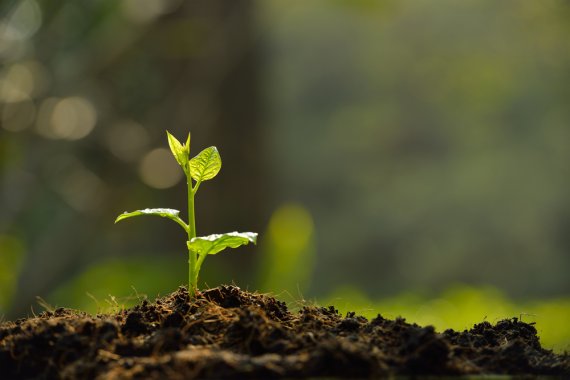© Shutterstock
Miniscule mechanical forces play a key role in a plant’s functioning, such as its growth. With the new method, researchers can now reveal these invisible forces at work on the cells. This is a first. ‘For many years it was believed that biological forces were driven by chemical reactions. But it has recently become clear to us that this was not the whole story,’ says Dolf Weijers, professor of Biochemistry. ‘We now know that mechanical forces play an important role too.’ These forces strengthen the stalk, for instance, so that it doesn’t snap, and they determine the plant’s shape and direction of growth.
Until now, however, it was impossible to observe and document these forces in the cell, because they are so small that researchers could not measure their effect on cells. ‘And if you really want to understand how it works, you have to be able to measure what happens,’ says Joris Sprakel, professor of Physical Chemistry and Soft Matter. He and his group have been working for years on methods of measuring miniscule forces, including a method that makes use of synthetic molecules that change colour when put under pressure. But they have never before done so in living cells.
If you really want to understand how it works, you have to be able to measure what happens. And that is possible now
Joris Sprakel, professor of Physical Chemistry and Soft Matter
Extraordinary collaboration
Sprakel and Weijers decided to collaborate on this a few years ago. This is an unusual collaboration, as a biologist and a physical chemist are not often likely to run into each other during their coffee break. But that can happen in Helix, and it turned out to be a successful bit of cross-pollination. The researchers and their group have successfully developed a method that can measure the miniscule forces at work in biological material. Weijers: ‘We can now record very precisely the forces in living plant cells, and correlate them with the cells’ behaviour. A dividing cell, for example, splits precisely down the middle. But how does the cell know where the middle is? Mechanical forces play a role in that.’
Different colours indicate the forces in the cells of a plant root. © Dr Vera Gorelova
No easy task
It was no easy task, says Sprakel. ‘Biological processes are unpredictable. In fact, they are an out-of-control mess compared with the structured materials I normally work with.’ He found, for example, that the molecules he uses in materials as measuring instruments don’t work in cells. Weijers: ‘You are putting an alien object into the plant but you don’t want to influence the cell; you are trying to measure the natural situation.’ So other, smaller molecules were needed that were water-soluble and could be introduced into the cell.
Next steps
The discipline of mechanobiology, which studies the physical stimuli in biological processes, is already quite well established in relation to microbes and animals. But in the world of plants, it is still in its infancy. Weijers: ‘Now that we can measure these forces better, we can see a lot of new details, and that raises new questions to explore. After all, you can’t ask questions about things before you know of their existence.’ Sprakel: ‘The first stage of the research focussed strongly on the chemistry, investigating how we can make these forces visible, and where they were. Now we can look beyond that and get a better idea of how it works.’
Weijers and Sprakel are going to work on this with their joint team in the coming years. The research has been published in The Proceedings of the National Academy of Science USA.
Also read:
Mystery of plant hormone solved
Plant and animal cells have the same sense of direction
Two building blocks caused plants to grow upwards
Physical chemist Joris Sprakel is always exploring new territory: ‘I can’t stand monotony’
Paint that never fades

